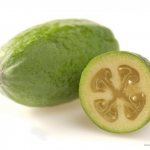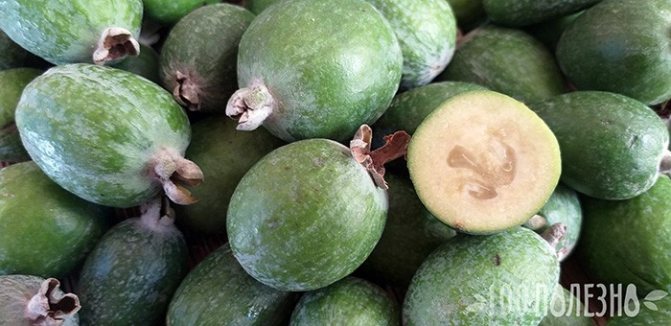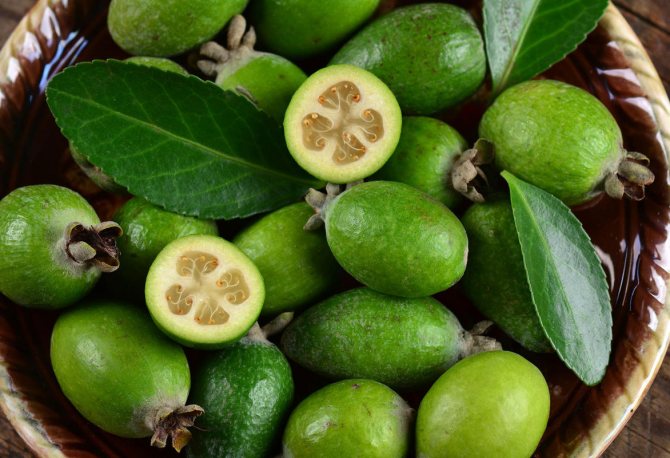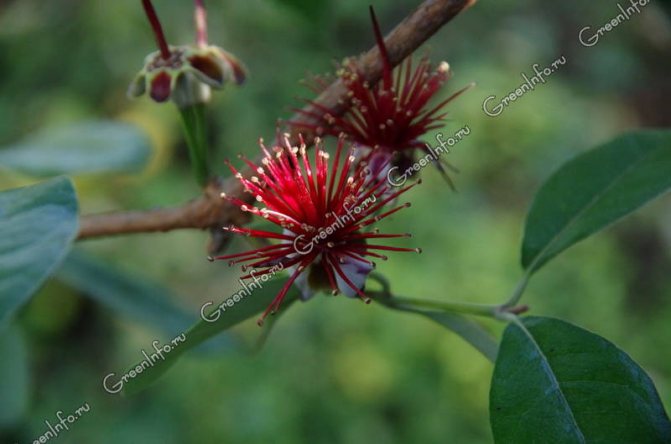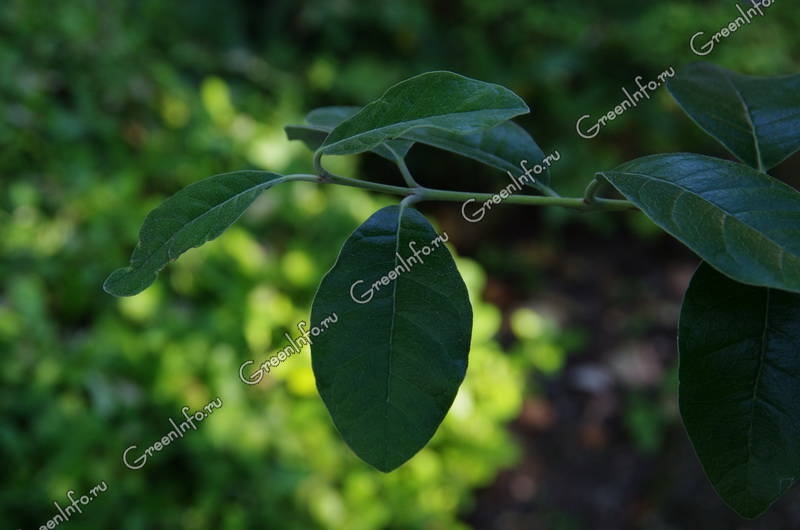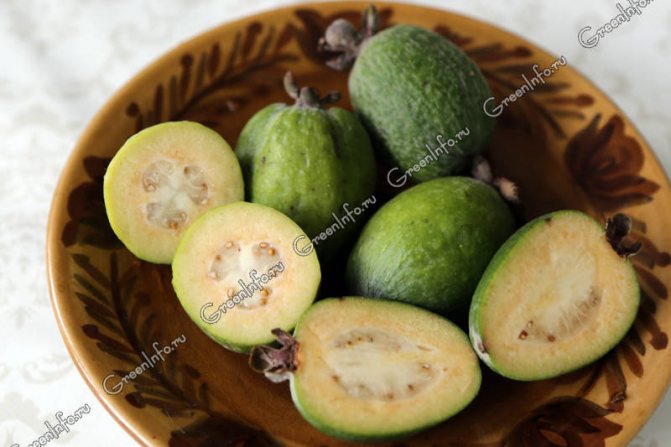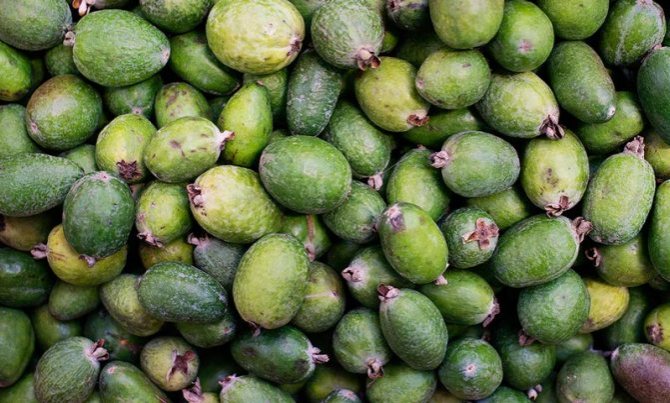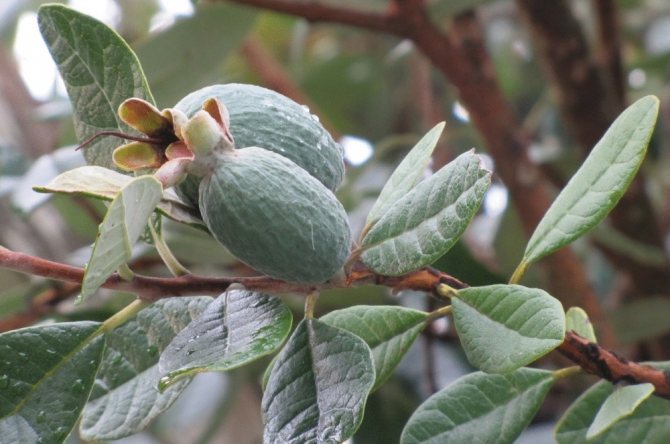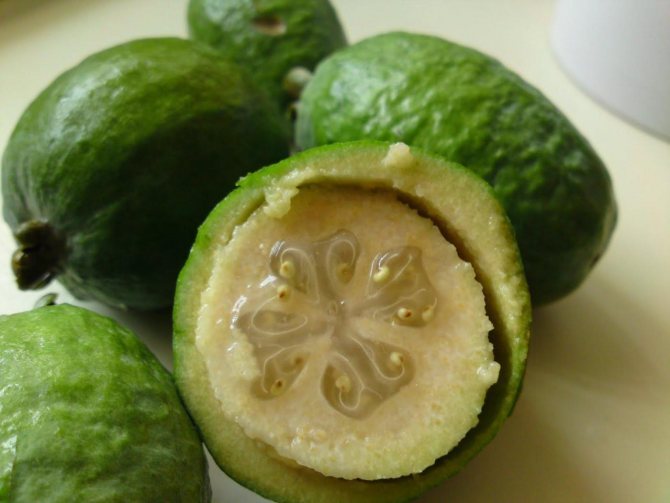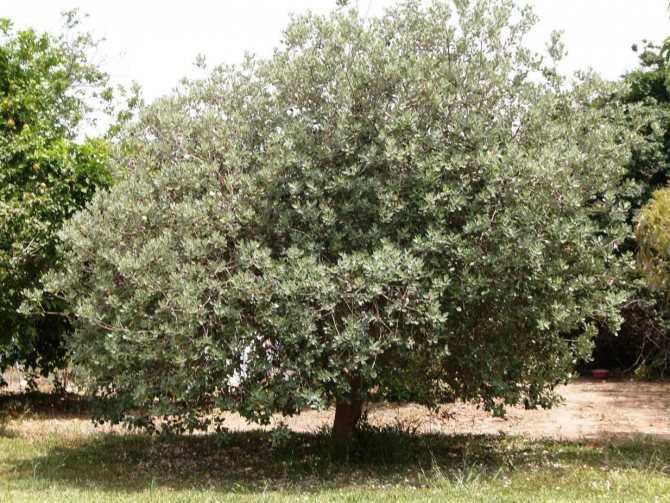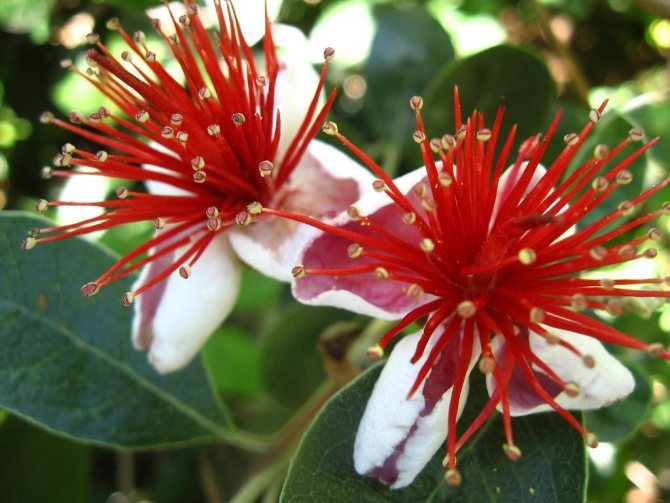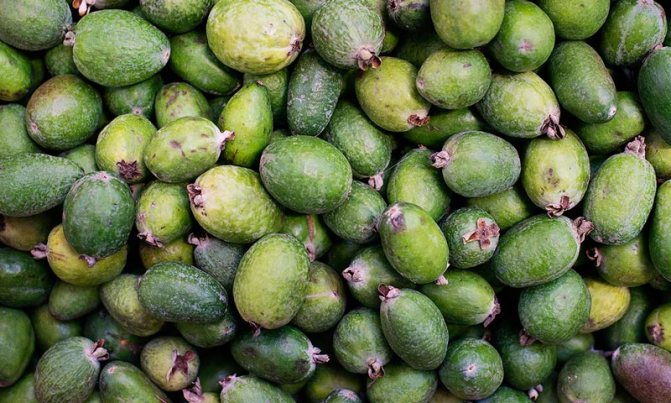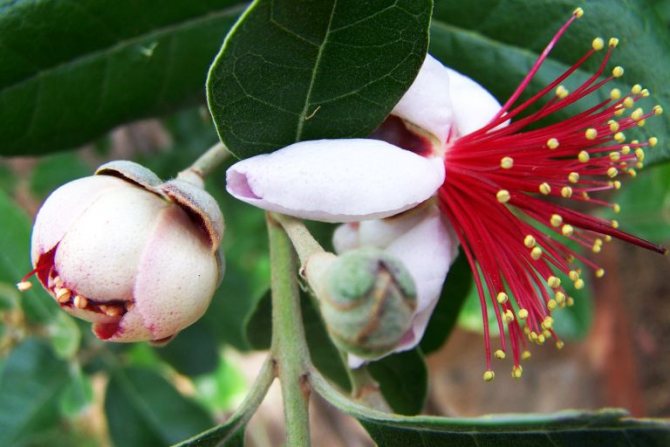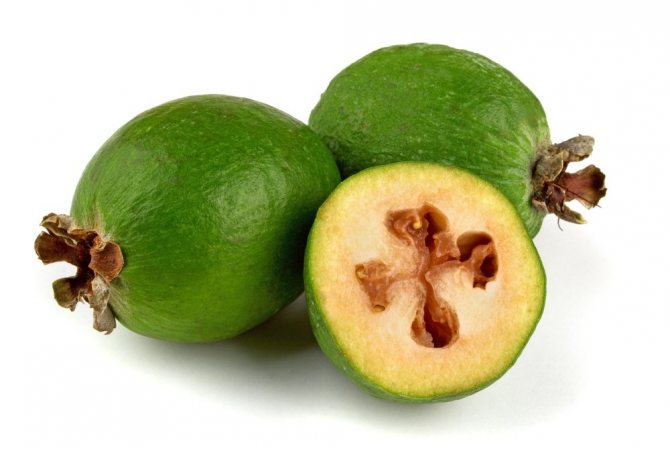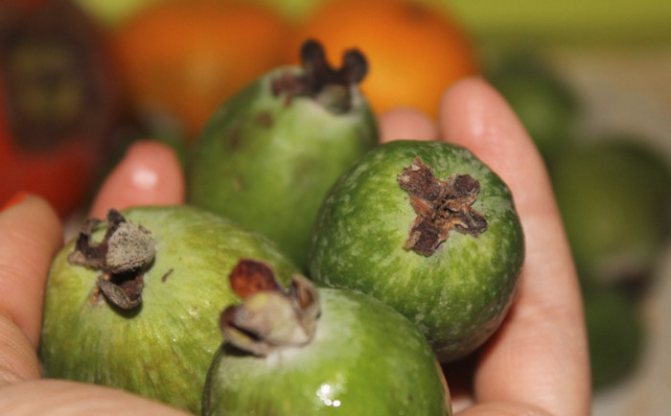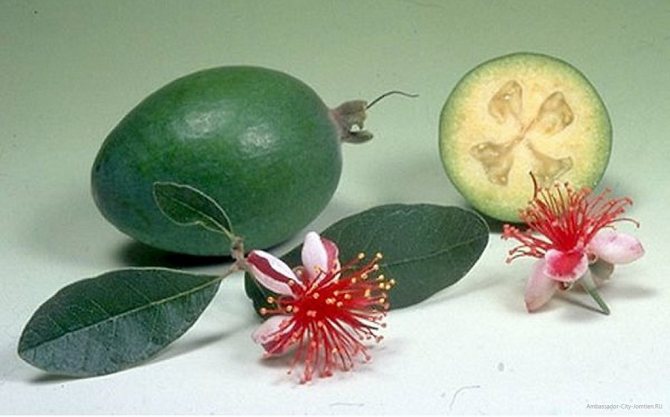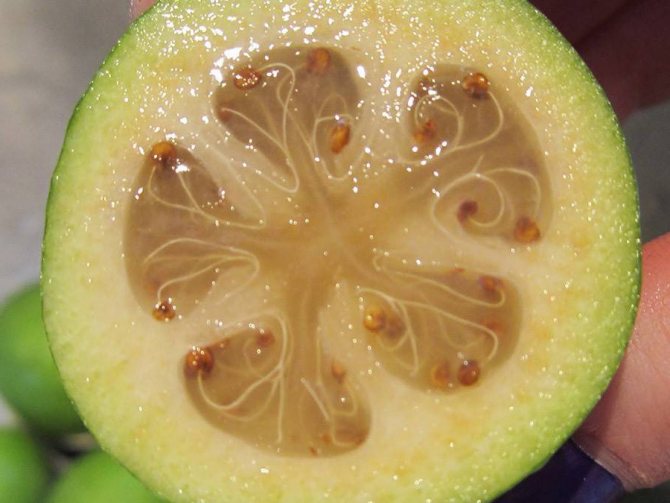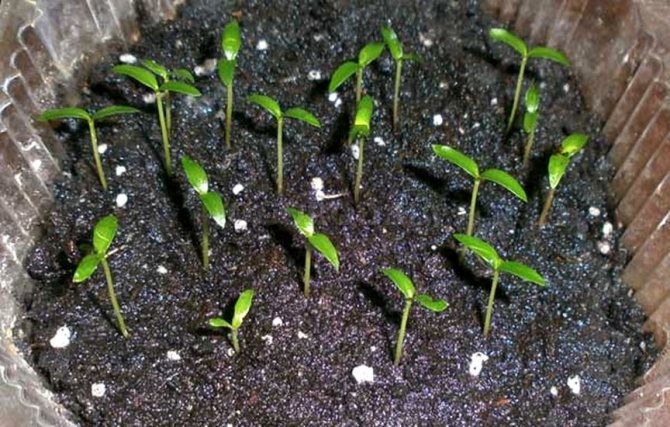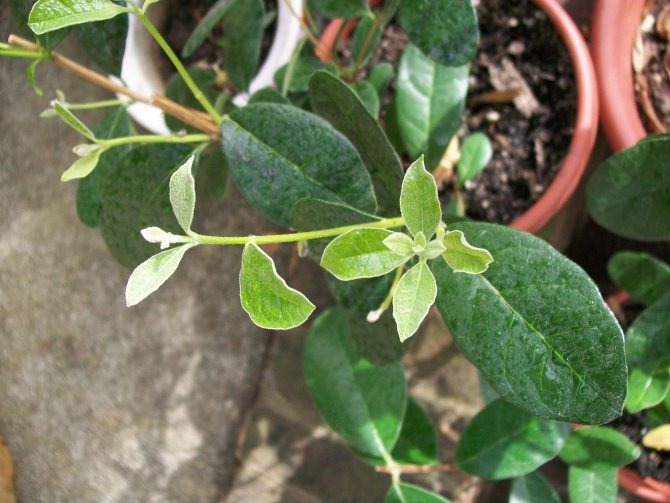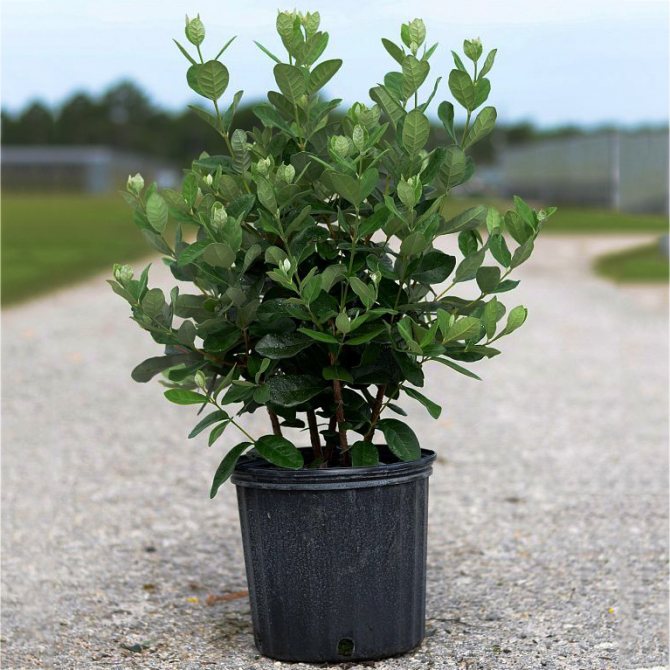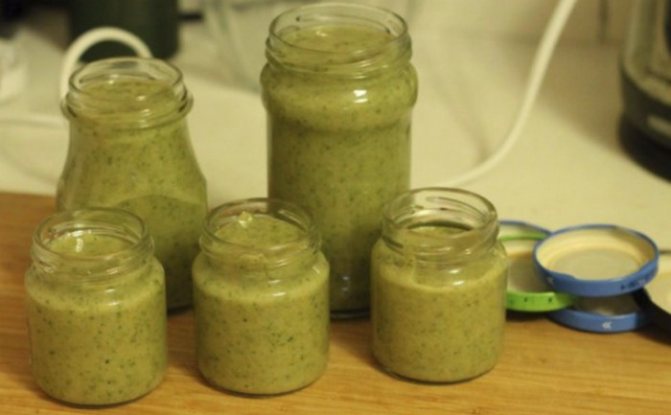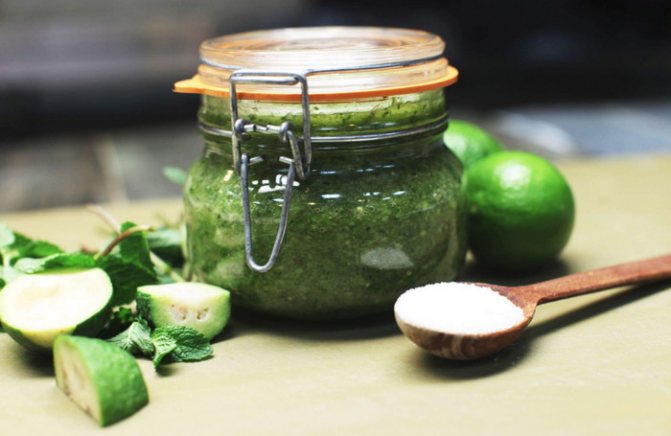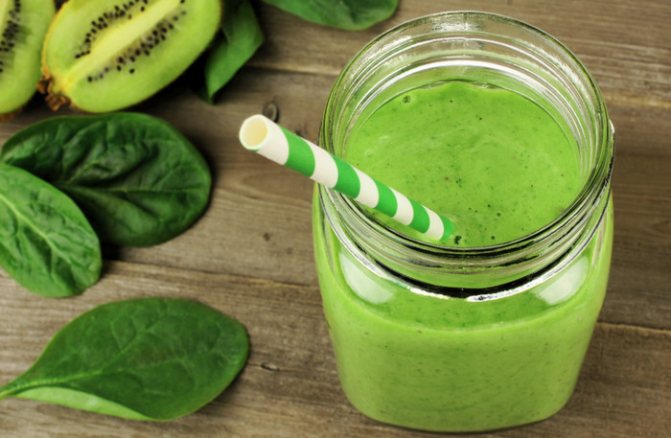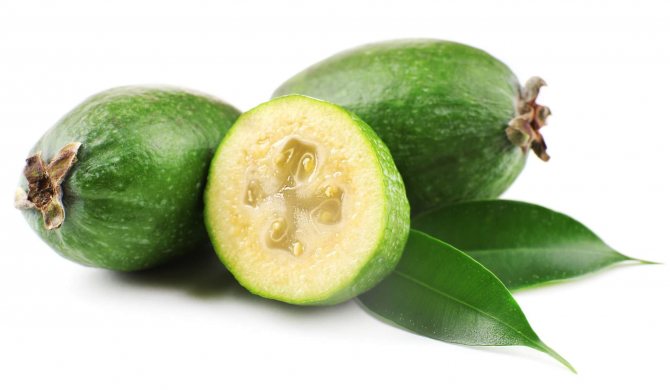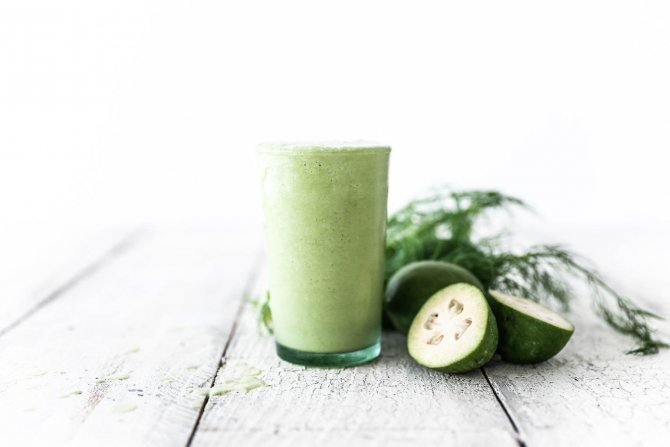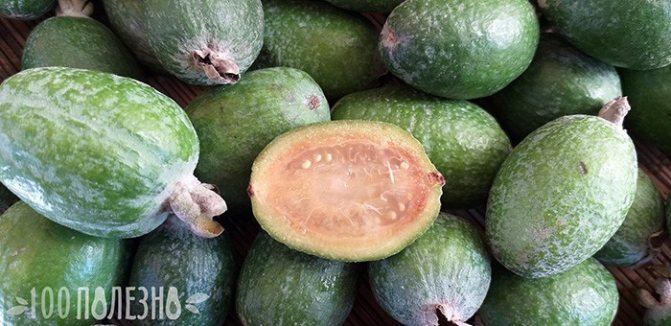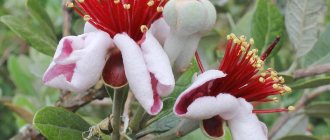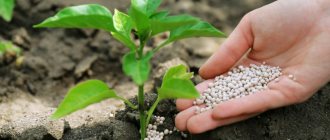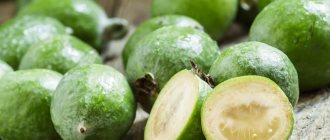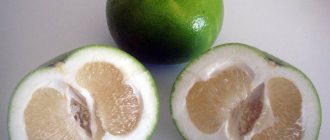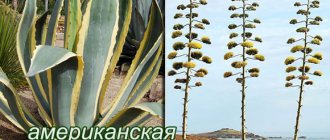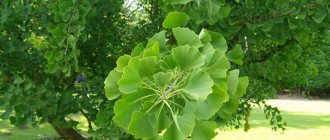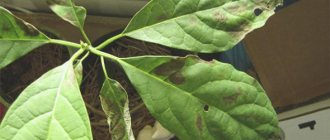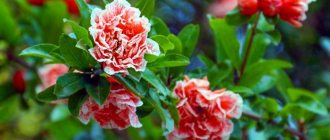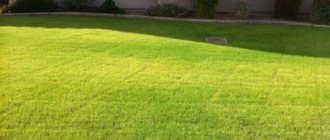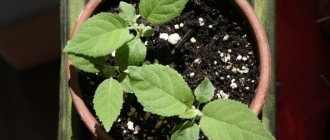Photo of Feijoa fruit
Unlike most exotic fruits of Thailand, civilized mankind got acquainted with feijoa relatively recently. The German botanist Friedrich Sello, from whose surname the species name feijoa was later formed, discovered the fruit in the forests of South America in the middle of the 19th century. The fruit got its generic name from the surname Johnny de Silva Feijo - director of the Museum of Natural History of Brazil.
Feijoa was introduced to Europe in 1890, to the botanical gardens of Sukhumi and Yalta - in 1900, to California - in 1901, and to Italy - in 1913. From Italy, the plant spread throughout the Mediterranean, and from there it “made its way” to Southeast Asia. This active "feijoa expansion" into the subtropics is facilitated by the fruit tree's ability to withstand frosts down to –12 ° C.
Today, feijoa is cultivated in the Caucasian countries, in the Crimea, Latin America, Turkmenistan, the countries of Southeast Asia (including Thailand), in Italy, New Zealand and Australia.
Planting and caring for feijoa
- Bloom: in spring or summer for three weeks.
- Landing: the seed is planted in a pot in late winter or early spring.
- Lighting: bright diffused light.
- Temperature: common for living quarters.
- Watering: regular, through the pallet.
- Air humidity: higher than usual. In winter, when the heating devices are working, it is recommended to spray the plant in the evenings with warm water.
- Top dressing: twice a month with organic solutions - mullein (1:10) or bird droppings (1:15). Mineral fertilizers are used as a last resort.
- Rest period: at home is not pronounced.
- Transfer: up to three years - annual, then - once every two years. Adult feijoa can be replanted once every five years, but the top layer of the potted medium needs to be changed annually.
- Cropping: in late autumn or early spring, when the plant reaches a height of 25-30 cm, it is shortened by a third. Sanitary and formative pruning is carried out at the same time as necessary.
- Reproduction: seeds and cuttings.
- Pests: red spider mites and false scutes.
- Diseases: gray rot.
- Properties: feijoa fruits have properties that are beneficial to humans.
Read more about growing feijoa below.
Feijoa for healthy skin
Green fruits are useful for cosmetic skin improvement and beauty maintenance. The vitamins contained in the fruits maintain optimal moisture content of the skin and their elasticity, relieve skin inflammation, and correct minor imperfections.
Important! Nutritional masks should not be used for general feijoa intolerance.
Making a feijoa mask for cosmetic procedures:
- Take 2 tbsp. l. ground feijoa pulp, mix with 1 tsp. almond oil and 1 tbsp. l. oatmeal gruel and chamomile broth.
- Apply the composition to clean, dry skin for 20 minutes, then rinse thoroughly.
- After the mask, you can rinse the skin with the remaining chamomile infusion.
- Apply 2 times a week. The lasting rejuvenation effect will be noticeable in 1-2 months.
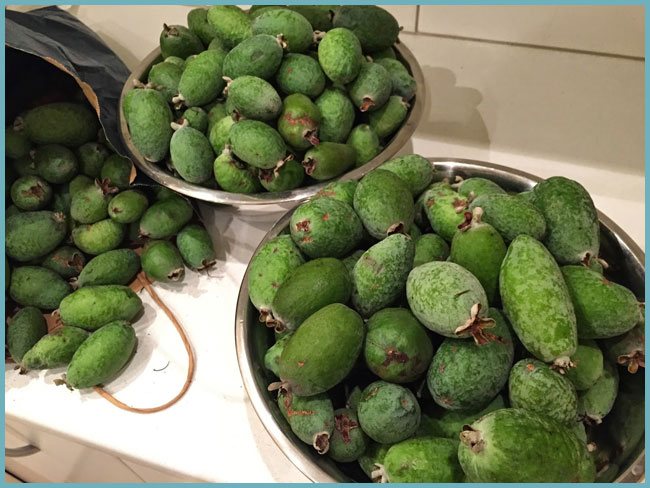
Good quality fruits should not have dark spots.
Legend and discovery
There is a legend about the origin of feijoa.About how the young man was in love with the sea princess, but yearned for the land. For the decision to return to solid land, the sea king turned him into a tree with the scent of the sea breeze at the fruit. A new plant was discovered at the end of the 19th century. in Brazil during a scientific expedition and got its name in honor of the director of the Museum of Natural History, João Feij. In Europe, the first fruit appeared in 1890 in France. From there, the feijoa was spread to the Mediterranean countries, the Crimea and the Caucasus. The tree is very thermophilic and can withstand maximum frosts down to -10 ° C.
What is Feijoa
The unusual name comes from the name of the discoverer of feijoa, botanist João da Silva Feijo, who at the end of the 19th century discovered a wild evergreen tree with feijoa fruits in Brazil. From there, due to its properties, this plant spread in many countries of the world with tropical and subtropical climates, including in the southern regions of Russia.
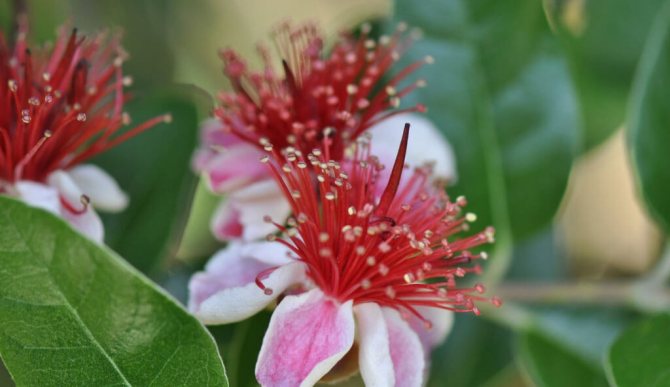

Feijoa is a berry that combines pineapple, kiwi and strawberry flavors with an incomparable fresh aroma. The fruits of feijoa trees or shrubs of the Akkka genus of the Myrtle family are considered berries due to the large number of seeds in the juicy, fleshy pulp.
Feijoa - description
Feijoa is a large spreading shrub or tree up to 4 m high with a superficial, compact, but densely branched root system. The trunk of the plant is covered with a rough greenish-brown bark. Criss-cross opposite leathery feijoa leaves with feathery venation, whole-edged, oval and often drooping, located on short petioles. The upper side of the leaf plate is smooth, dark green, the lower one is greenish-gray, pubescent. The four-membered bisexual axillary flowers of the feijoa can be single, paired, or, in several pieces, form a corymbose inflorescence. They have a lot of stamens - from 50 to 80, and the petals painted in white color acquire a pink tint closer to the base. Flowering lasts about three weeks. Feijoa is pollinated by insects. The fruit of the plant is a juicy, fleshy, dark green, cuboid berry, broadly round or elongated-oval in shape, 2 to 7 cm long and 1.5 to 5 cm in diameter. Inside the fruit there are seeds surrounded by translucent pulp. The taste and aroma of the feijoa fruit are reminiscent of kiwi, pineapple and strawberries at the same time. The color of the bumpy skin of the fruit can vary from yellow-green to dark green, sometimes with a purple-violet bloom of anthocyanin.
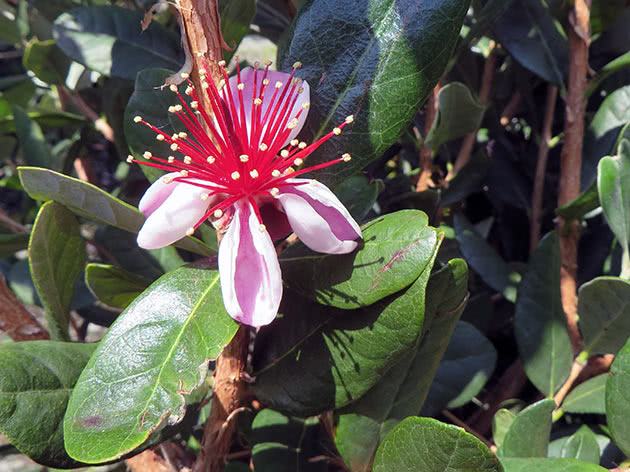

In the photo: How feijoa blooms in the garden
What does a feijoa look like
The genus Akka, to which the feijoa belongs, unites several species that naturally grow in South America. These fruit and ornamental plants are common in many subtropical countries. It makes no sense to argue about a feijoa, what is it - a bush or a tree. This species includes both shrubs and evergreen trees.
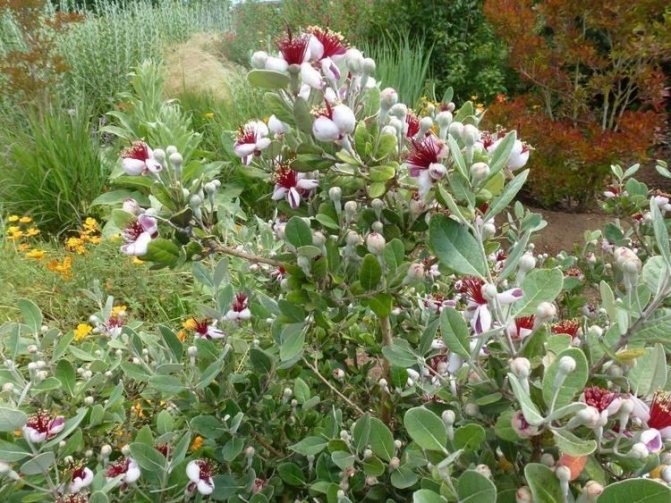

Feijoa in the open field
The plant with a rough light brown bark and a dense crown reaches 4 m in height. The outer part of the oval rigid leaves is dark green, glossy, and the lower part of the leaf plate is silvery-gray, pubescent. When rubbed, the leaves emit the smell of myrtle (the plant belongs to the myrtle family) and secrete substances that inhibit bacteria and fungi.
Feijoa bloom time is June. On the shoots of the current year, flowers are formed in the axils of the leaves, single or in small inflorescences. Flowers on long stalks, four-petal. Petals are oval, smooth, purple-pink inside, white outside. Long, numerous pink stamens topped with golden anthers. Feijoa blooms for about three weeks.
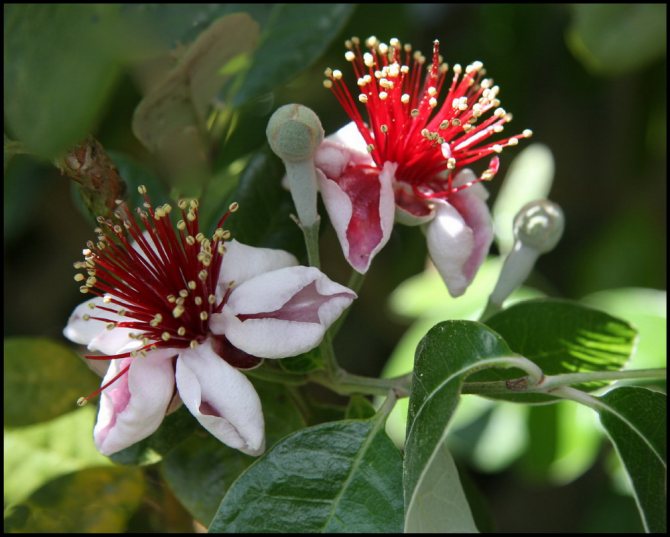

Feijoa bloom
On a note! Feijoa flowers are juicy and sweet in taste. In South America, they are eaten.
Feijoa is a fruit or a berry
Feijoa ripens when four months have passed after pollination. Formed green oval fruits up to 7 cm long.The pulp is dense, creamy, sweet and sour taste. The seeds are small, located in four small-seeded nests. Many people doubt: is the feijoa fruit a fruit or a berry? Despite the fact that the fruits ripen on the tree, the international classification classifies them as berries.
The aromatic berries have a refreshing, pleasant taste and are quickly absorbed. By the amount of iodine in fruits, feijoa surpasses other berries and can even compete with seafood. The fruits contain many vitamins, minerals, sodium, phosphorus, potassium, iron, zinc and pectins. The benefits of feijoa are undeniable, it is not for nothing that they call it the berry of youth and health.
The fruits are most often eaten fresh, sometimes seasoned with sugar. Also, jam, compotes, jams, marmalade are made from berries.
With regular use of feijoa for a long period (at least a month), there is a positive effect on human health. Happens:
- normalization of the thyroid gland as a result of iodine intake;
- increased hemoglobin due to the high iron content in fruits;
- regulation of blood glucose due to the low glycemic index of the product;
- improvement of the genitourinary system due to the diuretic properties of berries;
- strengthening of immunity.
Contraindication for the use of feijoa is an individual intolerance to the product. In order not to harm, provoking an allergic reaction to any of the components of the berries, you need to start with small doses, gradually increasing the amount of the product consumed. The norm recommended by nutritionists for an adult is 5 fruits per day.
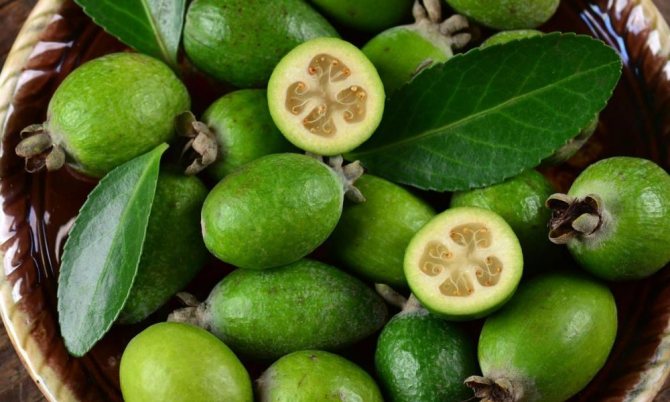

Feijoa fruits
How to choose and save correctly?
Feijoa fruits ripen by the end of autumn, when the winter cold weather has already set in most of the country. On the shelves, they often appear immature - it is easier to transport this way. The berries grow well under normal room conditions. It only takes a few days.
In order not to be mistaken with the choice, pay attention to the fruit in the cut. Sellers often display the sample for buyers to see. If the middle is transparent, then the product is completely ready for use, white is still green, and brown is already overripe.
You can determine the degree of maturity by touch. The best fruits are moderately soft, free from damage or dark spots. When ripe, they will stay in the refrigerator for up to two weeks.
How to save feijoa for the winter - the easiest way
The exotic berry has a lot of advantages and one drawback - too short storage period. The healing properties are so high that it is worth thinking about how to preserve, if not until the next harvest, then at least until spring. There is such a way. To do this, it is enough to rub the feijoa with sugar or honey.
It is convenient to use a blender for chopping. I take out the meat grinder the old fashioned way. I have a special "unit" for this. He never comes into contact with meat. I turn clean dry berries once and mix thoroughly with an equal amount of sugar. I don’t peel off the skin, it is the most valuable thing.
Cold "jam" is stored in a cool place until spring, checked. Longer - no, everything is eaten.
The main value of the workpiece is that in the absence of heating, all vitamins are retained in their original amount.
Feijoa with honey: a recipe for the winter without cooking
This option is more useful than the previous one. Instead of a harmful product, they put natural honey. The proportions are about the same. For a kilogram of feijoa, I take a 0.75 liter can. Scrolling, pouring honey, stirring - all the cases.
If the honey is candied, then slightly heat it over low heat. You don't need to preserve or roll up anything. The resulting mass smells just incredibly tasty. I pour it into dry jars, put it in the refrigerator.
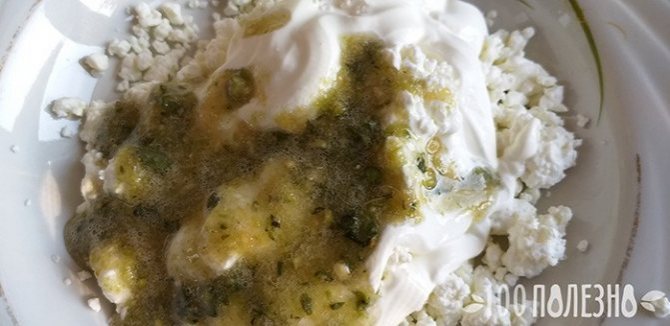

"Cold jam" goes well with cottage cheese and sour cream
You can use this dessert in different ways.One of my favorites is to top with ice cream or fruit salad. Another option is to spread it over toast or cookies. You can just eat with a spoon. The main thing is to stop in time.
Feijoa compote
A delicious vitamin drink will delight even seasoned gourmets. It's easy to make:
How to choose and store feijoa
A good feijoa ─ with a green (possibly a slight shade of gray) skin, firm and firm to the touch. Ideally, before buying, ask the seller to cut one of the fruits: if the pulp is light, almost transparent, like a jelly in consistency, you have a ripe fruit in front of you. If brown, then the fruit, alas, has deteriorated. White flesh means the fruit needs to ripen. As a rule, sellers in the market prefer to sell slightly immature feijoa. To ripen the fruit, you need to keep the fruit for several days at room temperature. It is best to store feijoa in the refrigerator in the fruit compartment, but no more than one week.
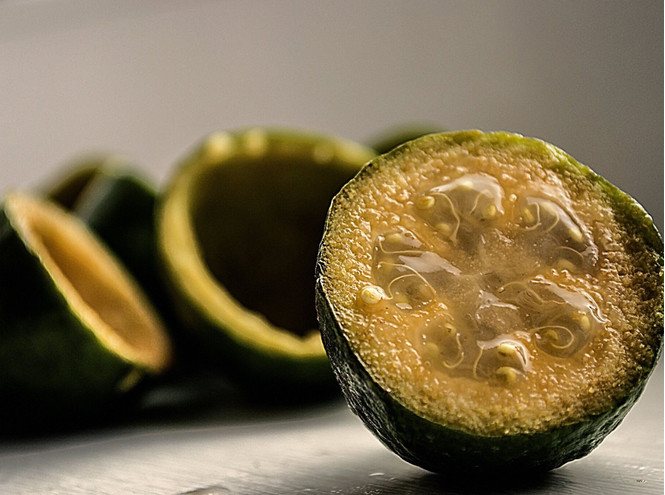

Growing feijoa at home
Feijoa landing
Today, it is becoming more and more popular to grow exotic plants in city apartments, so we decided to tell you how to get a feijoa tree from a stone. Place the ripe fruit with a yellowish skin in a warm place to ripen. When the fruit becomes soft, open it, take out the pulp with seeds, spread it over a dense cloth and wash off the mucus with water, then dry the seeds remaining on the fabric and sow them in a substrate consisting of equal parts of turf soil and river sand, placed in a pot with drainage holes on top of a layer of expanded clay or sand. To make the seeds lay evenly, they are pre-mixed with sand. After sowing, the seeds are pressed tightly to the substrate, without deepening, and sprayed from a spray bottle with a pale pink solution of potassium permanganate. Then the crops are covered with glass or foil and placed in a warm, bright place. While waiting for seedlings, the surface of the substrate is sprayed with water as needed, and the film or glass is cleaned of condensation.
- Areca at home: care and photos
Another exotic fruit on the windowsill - we grow lychees
Feijoa care at home
As a rule, the first feijoa shoots appear after a month or a little earlier, and you need to remove the weak seedlings immediately. For full growth and development, seedlings will need bright diffused light, so the optimal time for sowing feijoa is the end of winter or the beginning of spring. If the sowing was carried out in the fall, at the beginning or in the middle of winter, when the daylight hours are short and the seedlings may lack natural light, install a phytolamp or other lamp above the container at a height of 25 cm. However, the seedlings should be shaded from direct sunlight.


At the stage of development in seedlings, 2-4 pairs of true leaves are dived into separate pots with a substrate consisting of three parts of sod land, two parts of leaf humus with the addition of half a part of coarse-grained river sand and rotted manure. The pick is carried out in order to accelerate the development of the feijoa root system.
At first, seedlings grow very quickly, but feijoa from seeds will begin to bear fruit in the fifth or sixth year.
Watering feijoa
Feijoa is very hygrophilous. Overdrying the earthen coma can lead to the plant shedding leaves, and then its branches and roots will begin to die off, so you need to moisten the soil in the feijoa pot regularly, using the bottom watering method. Excess water is not drained from the pan: after a while it will be absorbed into the earthen lump. In winter, when the air in the house becomes too dry due to the heating devices operating at full capacity, it is necessary to spray the feijoa with water slightly warmer than room temperature in the evenings.
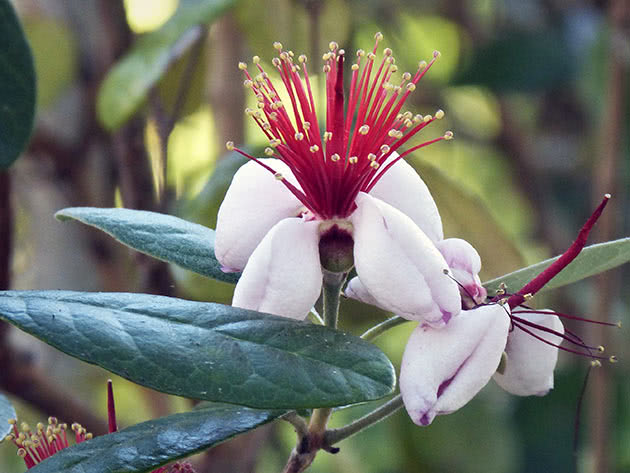

Photo: Flowering feijoa bush
Feijoa fertilizer
The growing feijoa constantly needs nutrients, therefore, fertilizers must be applied to the substrate all year round twice a month, and organic matter for feijoa is preferable to mineral complexes.The plant responds well to a solution of mullein (1:10) or bird droppings (1:15). Superphosphate is added from mineral fertilizers: 1 teaspoon is diluted in 1 liter of water, brought to a boil, and after the solution has cooled, diluted with water twice. Of the potash fertilizers, feijoa reacts best to ash extract: 1 tablespoon of ash from burnt straw or deciduous trees is stirred in 1 liter of water and infused for a week. Phosphate, potassium and nitrogen feeding alternate. All nutrient solutions are applied only to a pre-moistened substrate.
How to Grow Edible Pitted Lemon at Home
Feijoa transplant
Up to three years old, rapidly developing feijoa is annually transplanted into a substrate consisting of equal parts of peat, sand, humus, turf and leafy soil. Then it will be enough to change the substrate and dishes for the plant once every two years. Adult feijoa are transplanted once every five years. When transplanting, it is not necessary to completely clear the roots of the plant from old soil, if it is not sour and is not infected with pests or infection. You can simply transfer the feijoa from one pot to another, being careful: the roots of this plant are fragile.
- Areca at home: care and photos
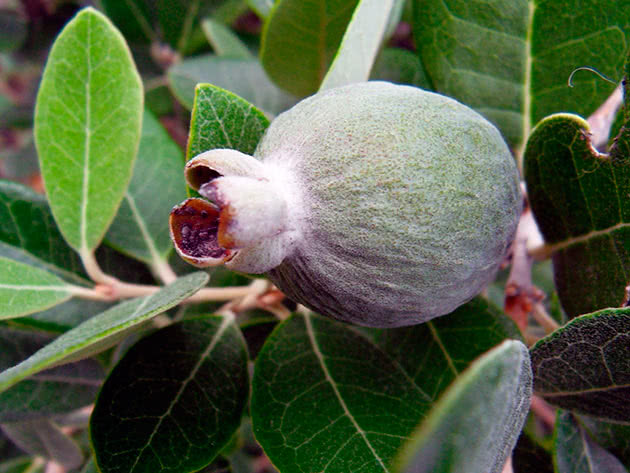

In the photo: Tying a feijoa fruit on a branch
Pruning feijoa
Since the feijoa at home can grow up to 6 meters or more, it has to be cut off. Correct pruning will not affect the fruiting of the tree in any way, and a beautifully formed crown will add attractiveness to the plant. Pruning feijoa in late autumn or early spring. You will need a knife or pruner, which must be kept in boiling water for half an hour before use or thoroughly wiped with rubbing alcohol. When the feijoa reaches a height of 25-30 cm, it is shortened by a third. Then, as necessary, form and sanitary pruning is carried out. First of all, growths are removed that extend from the trunk at an angle of less than 60-70 degrees, as well as competing branches and shoots rubbing against each other. The plant does not need weak, diseased, dry and damaged branches. If the feijoa is formed in the form of a tree, then everything that has grown on the lower quarter of the trunk is cut out: these branches and shoots will not bring you a lot of fruit, but the bush will take on a tree-like shape. In the future, you will need to regularly remove the root growth. When cutting branches, the pruner blade is set at an angle of 45º and cut away from the trunk, leaving short stumps that dry out very quickly. The wounds are treated with a fungicide solution.
Plant propagation
New specimens of the species can be obtained by separating root processes, by cuttings, and by sowing seeds. The easiest and fastest way to reproduce feijoa is to cut the root growth when transplanting an adult shrub.
Cutting is somewhat more difficult. In the fall, the largest branch in the crown of the mother plant is cut off. Remove all leaves, leaving only the top ones. Then the cutting is soaked in a solution of "Heteroauxin", a root growth stimulator. After 14-16 hours, it is planted in a container with disinfected soil (sand in half with humus), deepening by 2/3 of the length. Periodically, the cutting is sprayed with warm water and covered with a glass jar. The roots form in about 1 month. When propagated by shoots or cuttings, plants begin to bear fruit after 2-3 years.
The seeds can be extracted from the ripe yet unripe feijoa fruit. They need to be thoroughly rinsed and dried for 4-6 days. When sowing, the seeds are evenly distributed over the soil surface and covered with a soil layer of 4-5 mm. Its composition: leafy earth in half with peat and a little sand. Water the crops very carefully, preferably through a paper towel. The seeds should not be allowed to wash out onto the surface of the soil, or, conversely, their burial. Planted in November-December, they sprout in 1 month.Seedling fruits appear only after 6-7 years.
How to propagate a tree
Feijoa is propagated in several vegetative ways - cuttings, root suckers, layering and grafting. Seed propagation gives good results.
Seed method
Fig tree or fig - a description of what the fruit looks like
The simplest and most common way to get new specimens of feijoa is by seed propagation. This method also has a drawback. What is Seed Feijoa? It is impossible to predict what a seedling will look like - the result is a patchy planting material. Seedlings differ in the strength of growth, foliage and other vegetative characteristics.
To obtain high-quality planting material, seeds are harvested from the best specimens with high taste and decorative properties. The fruits are chosen large, ripe and wait for their complete softening, while preventing decay. Then the fruits are gently crushed and, with the help of repeated washing with water, the seeds are separated from the pulp residues. Then the seeds are dried.
Note! One feijoa fruit contains up to 30 small seeds. Accordingly, about three grams of seeds can be obtained from a kilogram of fresh berries.
Sowing is carried out in February - March in a low container filled with a mixture of earth, high peat and sand (2: 2: 1). Before sowing, the soil is slightly compacted and moistened. On the surface of the earth, grooves are made with a depth of 5 mm and seeds are distributed in them at a distance of 3-5 cm from each other. Crops are covered with soil and moistened with a spray bottle. The container is covered with cellophane and placed in a bright place. The temperature is maintained in the range of 16-20 ℃.
Shoots appear in a month. The greenhouse is aired daily, and over time, the cellophane is removed completely. When 2-3 pairs of true leaves appear in young plants, they are transplanted into separate containers, pinching the taproot. The substrate for grown seedlings is heavier and more fertile: 6 parts of sod land, 4 parts of leaf and one part of sand and humus.
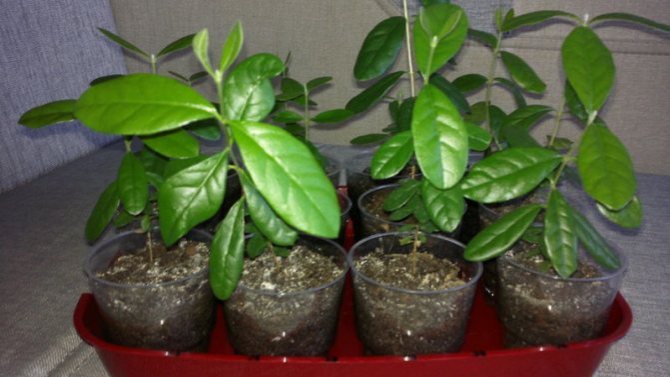

Feijoa seedlings
Cuttings
In autumn, cuttings are cut from the upper and middle parts of semi-lignified shoots. Their length is 8-10 cm, each should have three knots. The stalk is treated with Kornevin and obliquely placed in the substrate, burying the lower node into the ground. The earth is moistened and the plant is covered with a glass jar. Feijoa cuttings are difficult to root; bottom heating can be used for stimulation. In case of successful rooting, after about two months, the seedlings are transferred to pots with a nutrient substrate.
Layers
A more reliable method of vegetative propagation is by layering. But this method takes a long time and the availability of suitable branches. For layering, the lower part of the bush is used, which has a limited number of shoots.
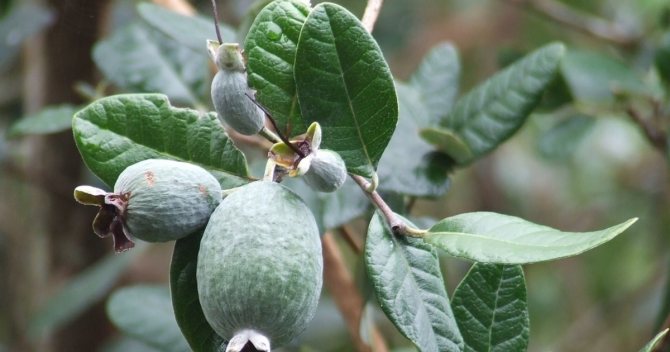

Feijoa fruiting
In the spring, small cuts are made on the lower young shoots. The twigs are pressed to the ground, fixing with staples in shallow grooves. From above, the layers are covered with nutritious loose earth. The soil above the layers is regularly moistened. Rooting occurs after 5 months, after which the layers are separated from the mother plants and seated in separate containers.
Additional Information! Feijoa seedlings bear fruit at the age of 5-6 years, and plants obtained as a result of vegetative propagation begin to bloom and bear fruit in the second or third year.
Possible growing problems
Both garden and indoor forms of feijoa are disease resistant. In tubular specimens, vegetation problems may be associated with improper care - excessive watering or, on the contrary, overdrying of the earthen coma. These issues are addressed by optimizing the conditions of detention.
Sometimes sucking pests settle on feijoa: scale insects and ticks. Scabbards are crawling insects with a wax shield in the form of a convex growth.Ticks are very small pests, the presence of which can be determined by the presence of a thin cobweb on the plants. In case of severe infection, insect and acaricides are used. If the lesions are single, the pests can be collected by hand and the plant washed with soapy water.
Akka is a plant that is as decorative as it is useful. Along with the healing and tasty fruits, feijoa has a beautiful crown and spectacular flowering, which allows the culture to successfully compete with other indoor plants.
Feijoa blanks
It is better to eat fresh berries. Feijoa fruits can be eaten peeled or directly with the skin - if desired. They can be added to fruit and vegetable salads, sauces, yoghurts, cocktails. Feijoa will give an original taste to pastries, meat and fish dishes.
Berries are poorly stored fresh - about a week, but they can be harvested for future use in any known way:
- Freezing. The berries, peeled or directly with the skin, are cut into slices, rings, cubes, rolled through a meat grinder or chopped with a blender - if desired, laid out in containers, bags and placed in the freezer
- Live jam, mashed potatoes. The berries are crushed with a blender or in a meat grinder, sugar or honey is added to the mass in a 1: 1 ratio. Ready "jam" is mixed and laid out in jars, covered with plastic, glass or screw lids. Store in a refrigerator in a cool place.
- Common jam. For 1 kg of berries, 200-300 g of sugar is enough. Any method of cooking. From feijoa you can make jams, jam, "transparent" jam. There are no restrictions on adding additional components to the jam - cinnamon, cloves, lemon, orange, ginger, mint, etc.
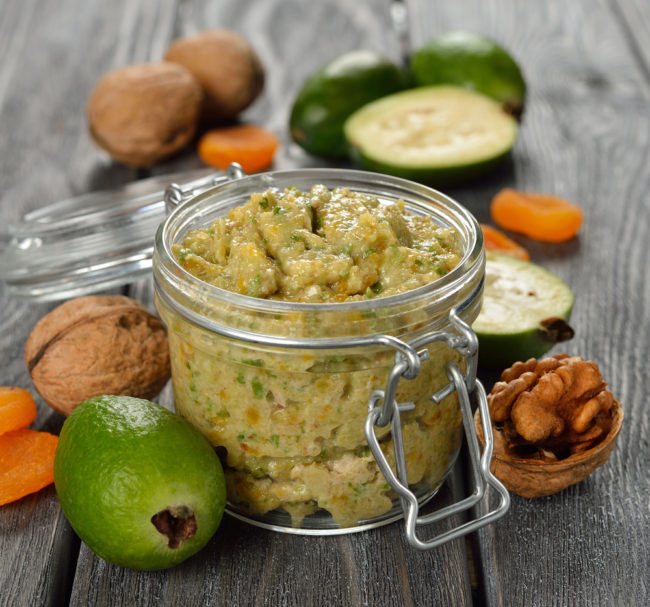

Feijoa dish
- Feijoa sauce. Feijoa sauce is prepared in the same way, only without adding sugar. To add spice, it is best to add a little garlic, white or black pepper. This sauce goes especially well with meat and poultry dishes.
- Beetroot salad with feijoa and nuts. Ingredients: 1 medium beet, 100-200 g of feijoa, a few walnuts, vegetable oil, salt. Boil the beets and peel and grate. Peel and chop the feijoa. Chop the nuts. Mix all ingredients and season with vegetable oil and salt. Vegetable dietary salad contains fiber and vitamins, has a low calorie content, which makes it very useful for health and for weight loss after a heavy meal.
- Pork salad with feijoa and lime. Rinse the pork, dry and cut into thin bars. Rinse the feijoa and lime and cut into circles. Cut the onion into thin strips. Heat the vegetable oil well in a frying pan. Fry the pork pieces for 3 minutes. Then add lime, feijoa and onion. Cook for another 3 minutes. Top up with soy sauce, red wine, paprika and chopped cashews. Stir and remove from heat. Tear the mix of different types of salad into pieces and mix with mayonnaise and low-fat yogurt. Unusual holiday salad is ready!
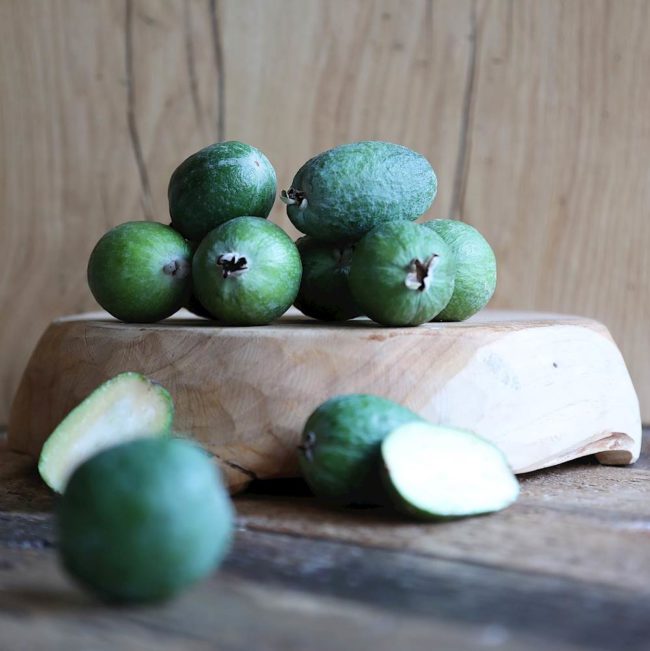

Feijoa fruit
- Compote. Compote can be made from whole berries or chopped berries. You can also add other fruits, spices.
- The juice. If you managed to purchase a large number of feijoa berries, then you can prepare the juice. Freshly squeezed juice is simply brought to a boil (boil for no more than 2-3 minutes), poured into jars and rolled up.
- Feijoa chicken. Bone the chicken and cut into pieces about 4x6 cm. Next, prepare the marinade from lemon juice, warm water, salt, sugar, chicken spices and bay leaves. Put the chicken pieces in the marinade and keep there for 2.5 hours. At this time, peel the feijoa and cut it across into thin circles (about 0.3 cm). After the marinade, place the chicken in a frying pan with high edges, add a little marinade there and then shift the feijoa pieces with chicken pieces.Sprinkle with parmesan grated on a fine grater on top, add a few cilantro twigs and cover it all with foil, bending it over the edges of the pan. Bake for about 50 minutes at 150c.
- Feijoa tincture with cranberries. Wash and crush half a glass of cranberries. Feijoa (200 g), wash, peel and chop randomly. Put everything in a container with a volume of 700 ml. Prepare sugar syrup: Dissolve 50 g of sugar in 75 ml of water and bring to a boil. Pour the syrup into a container with berries. Fill the container with vodka to full, stir and close. Insist in a dark place for at least a week.
Video
Feijoa pests and diseases
Feijoa diseases
Feijoa is very rarely affected by diseases, and if you create the conditions necessary for the successful development of the plant and take proper care of it, then you will not have problems with this exotic. With poor care or violation of the watering regime, the plant can get sick with gray rot. In rare cases, feijoa can affect leaf spots. Pathogens of fungal origin are destroyed with Bordeaux liquid, and the areas affected by gray rot are cut out with the capture of healthy tissue, after which the feijoa is abundantly treated with a fungicide solution. However, if you do not reconsider the watering regime, gray rot may return.
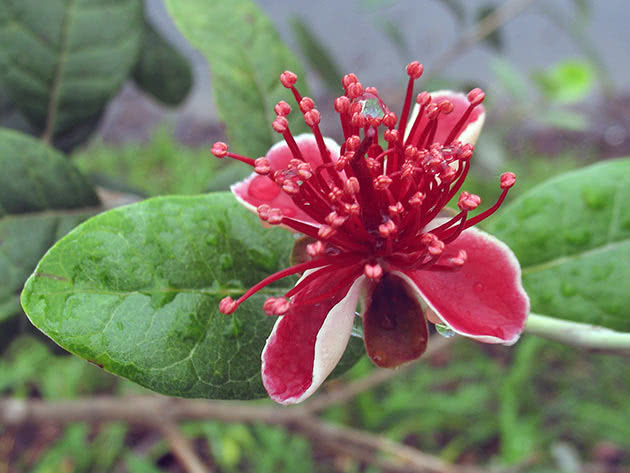

In the photo: A flower on a feijoa bush
Feijoa pests
Of the pests, red spider mites and false shields are dangerous for feijoa. Spider mites are more likely to damage young leaves and shoots. Get rid of them with the help of Keltan: dissolve 2 g of the drug in 1 liter of water. It is better to process it in the evening so that the plant does not get burned in the sun. The action of the drug lasts about 40 days, so one spraying will be enough. In the future, as a preventive measure, wash the feijoa in the shower from time to time: ticks do not like a humid environment.
False scutes settle along the central vein of the upper side of feijoa leaves. An effective remedy against these pests is Karbofos, 5-6 g of which is dissolved in a liter of water. Feijoa is treated with this emulsion over the leaves, trying to wet each of them on both sides. You will need two or three such treatments. They are carried out at intervals of 5-7 days.
Feijoa and cooking
This fruit is used not only in its natural form. It is included in various dishes. This is not only a dessert, but also savory second courses. If the feijoa fruit is so widely used, why is it useful in cooking? What can you cook using it?
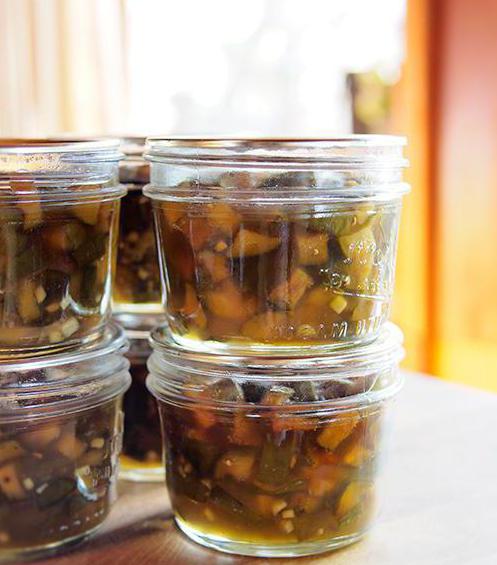

It is added to sauces, vegetable side dishes. It is considered indispensable in vitamin drinks, lemonades, homemade juices. Pancakes are especially tasty if you add feijoa pulp to the dough. The layer in the cake is also excellent!
Anyone who loves exquisite taste will definitely try all the options for dishes from feijoa, the useful properties of which are so in demand in cooking.
FAQ
Feijoa is a very interesting and, at the same time, little-known plant for us, therefore, questions related to it often arise - we will try to answer the most popular of them in question-answer mode.
Feijoa fruit or berry?
Feijoa fruits are quite large for berries, so many consider them to be fruits, but this is wrong - feijoa is a berry.
What vitamins do feijoa contain?
100 grams of feijoa contains the following vitamins (average figures are given, which may differ depending on the variety and place of growth):
- Vitamin C - 32.9 mg
- Vitamin E - 0.16 mg
- Vitamin K - 3.5 mcg
- Pantothenic Acid - 0.223 mcg
- Niocin - 0.295 mcg
- Pyridoxine - 0.067 mcg
- Riboflavin - 0.018 mcg
- Thiamine - 0.5 mcg
- Folate - 23 mcg
- Potassium - 0.155 mg
- Iodine - 0.3 mg
- Phosphorus - 20 mg
- Calcium - 17 mg
- Magnesium - 9 mg
- Sodium - 3 mg
- Manganese - 0.085 mg
- Iron - 0.08 mg
- Zinc - 0.04 mg
- Copper - 0.055 mg
Feijoa calories
The calorie content of feijoa is 49 kcal per 100 grams of product. Moreover, in berries it consists of the following:
- Carbohydrates - 10-15 g;
- Proteins - 1-2 g;
- Fat - 0.6-0.8 g;
- Fiber - 6-7 g.
How to eat feijoa - with or without peel?
From a nutritional point of view, feijoa berries are completely edible, including the peel. But, not everyone likes the peel for its taste, so it is rarely eaten raw, but when cooking jam or compotes, the fruits are used completely.
Description of the plant
Feijoa is an evergreen shrub that belongs to the Myrtle family. Its height can reach three meters. It is very beautiful during flowering - rich crimson inflorescences appear on the feijoa, on which there are white-pink specks. The foliage is dense, dark green. After flowering, fruits are formed that are similar in appearance to walnuts. The length of the berry is about five centimeters, and the weight, depending on the variety, can reach 20-120 grams. They are edible. The pulp is juicy in taste with a sweet and sour aftertaste. Something remotely reminiscent of the sweetish taste of strawberries and the sourness and astringency of kiwi. They are also similar in size to kiwi. They give a very rich harvest. Ripening occurs in late autumn, around the end of October or early November.
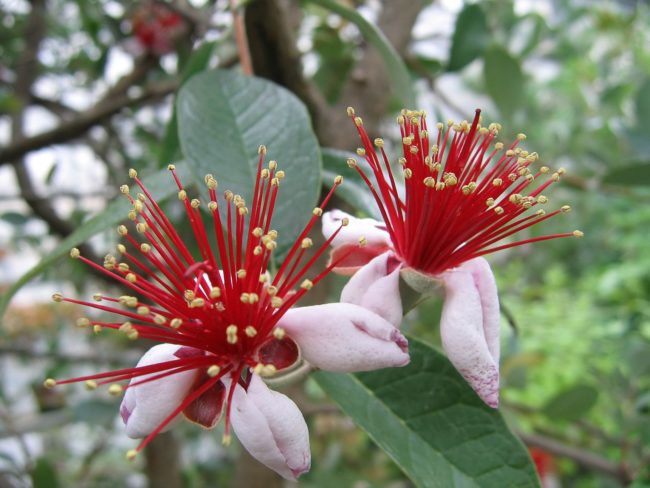

Feijoa flowers
Feijoa can withstand temperatures as low as -15 degrees. The fruits may last for a long time, so they are easy to transport and store. This fruit is sold in large supermarkets or in the market. The shrub can be found in Crimea, Azerbaijan, Ukraine or Krasnodar.
The size of the fruit depends on the conditions in which the feijoa is grown. The fruits can be:
- small;
- medium;
- large.
They can be eaten as a whole together with the skin, or only the pulp can be scraped out. This can be done with a spoon. The beneficial composition of this fruit makes feijoa a very valuable product. It is very much appreciated during the period of vitamin deficiency, as it helps to strengthen the body. It is also used to treat certain diseases.
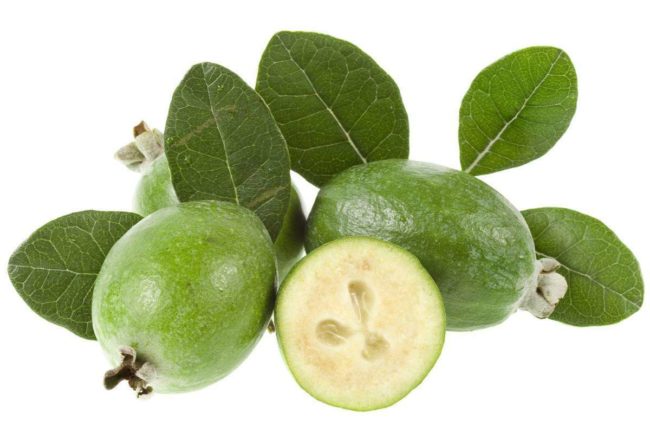

Feijoa photos
Breeding feijoa
Feijoa is propagated not only by seed, but also vegetatively - by cuttings. For grafting, you need half-ripe shoots with three internodes. Sections of cuttings are treated with a root former, after which they are planted in a light substrate. It can be coconut soil, vermiculite, perlite, well-washed river sand or flower soil, mixed in equal parts with perlite or vermiculite. The planted cuttings are covered with plastic bottles or glass jars and kept at a temperature of 23-25ºC. Root regrowth may take several months, and it may well happen that not all cuttings will take root.
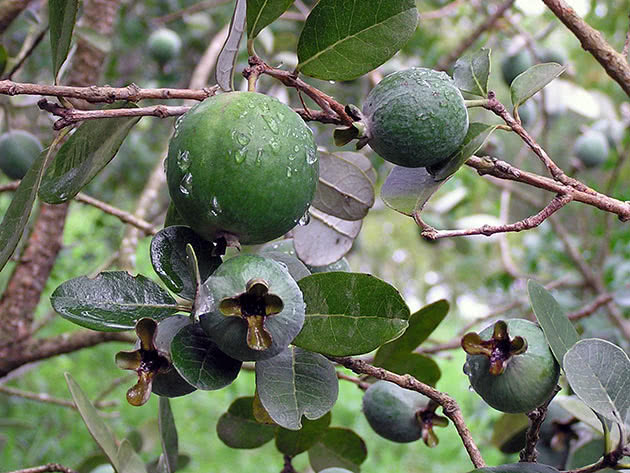

Photo: Cultivation of useful feijoa
Why is feijoa useful and for what diseases
This rare fruit is of great interest to medical professionals. Like any other exotic fruit, it is very attractive to itself and becomes the culprit of controversy. It is often discussed the question of how feijoa is useful and for what diseases it is beneficial.
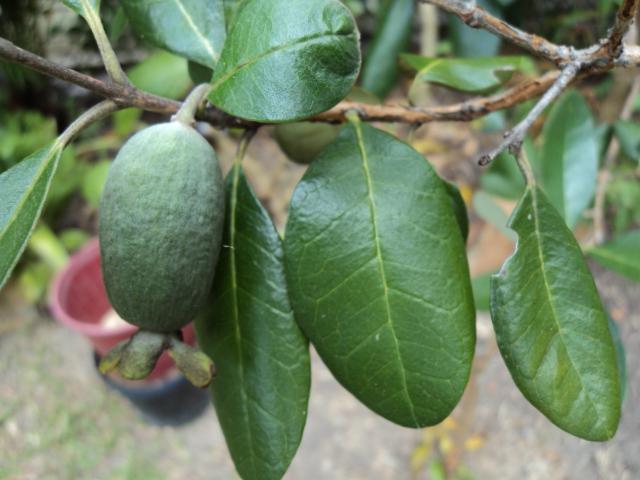

The benefits of feijoa are great, especially for people who have iodine deficiency in the body. In its composition, it is in a biologically available form.
Thanks to vitamin C, which is contained in fruits, the human body becomes stronger and more protected from various infectious diseases. This is especially noticeable in autumn and winter.
Everyone knows how feijoa is useful and what benefits the pectin contains for the body. Thanks to him, feijoa is considered an excellent natural laxative. The peel is rich in tannins, but should only be taken brewed. Such a drink or tea has a unique taste and is able to quickly eliminate all signs of poisoning. It is recommended to give it to adolescents and children, since the benefits for a not yet fully strengthened body are invaluable.
Here is a feijoa fruit. What else is it useful for? Useful properties include:
- The presence of trace elements and vitamins that can have anti-cancer effects.
- Participation along with other means in the normalization of blood pressure.
- The ability to cleanse the blood from hazardous substances.
First of all, people who have suspicions of apathy, lack of appetite, severe chills, and hair loss should seek help from feijoa. It is also useful for people with low hemoglobin and progressive atherosclerosis.
Care advice
Feijoa is a cross-pollinated plant. That is, in order for the flowers to pollinate, and the ovary appears, a second shrub will be needed. Or you will have to find a self-pollinated species. Of the varieties available in our country, these are "Crimean Early" and "Nikitsky Aromatic".
In all other cases, the shrub needs help to pollinate. It's not difficult to do this:
- with a cotton swab, pollen is carefully collected from the stamens of one plant;
- The cotton wool is clamped and the pollen is transferred to the flowers of another plant.
Ideally, use 2-3 bushes. This should be done for 5 years - earlier young plants do not bear fruit.
At first, the plant needs to be replanted every year. In this case, each time you need to pick up a pot 10 centimeters larger in diameter. In the third or fourth year, growth slows down. In the future, the feijoa should be relocated only if its root system has grown greatly. This is done by keeping a lump of soil around the roots. If they have grown too much, you can carefully cut them off, the plant will not suffer from this.
Feijoa needs regular and proper feeding. In the spring, during the growing season, mineral fertilizers containing nitrogen and potassium are optimally suited. If organic feeding is preferred, then chicken droppings work well. One part of the droppings is diluted in ten parts of water and the myrtle bush is fertilized with this solution.
When flowers appear, you should switch to phosphorus fertilizers from mineral fertilizers, and mullein from organic ones.
Feijoa species
Before we start growing feijoa as a house plant, let's find out about its main types:
- Andre. Feijoa variety that came from Brazil. Its fruits are medium in size, oblong or round, their surface is rough, light green in color. The pulp is thick, there are few seeds in it. The taste is very rich and full-bodied. The plant is self-fertile, always bearing many fruits.
- "Besson". The homeland of this variety is Uruguay. Fruits are small or medium, oval in shape, with a burgundy blush. The skin of the fruit is thin, the flesh is not very thick, fine-grained, juicy, aromatic, with many seeds.
- Coolidge. Mainly grown in California. The fruits are either oblong or pear-shaped, of medium size. The skin is slightly corrugated. The aroma of the fruit is uncertain. The plant is self-fertile, strong and erect.
- Superba. The fruits of this feijoa variety are round or slightly oval in shape, medium smooth, good taste. Not less than 33% self-fertile. Spreading bush of medium strength.
- Choiceana. Fruits are round or slightly oval, smooth, medium in size, pleasant to the palate. Medium vigor, 42% self-fertile plant.
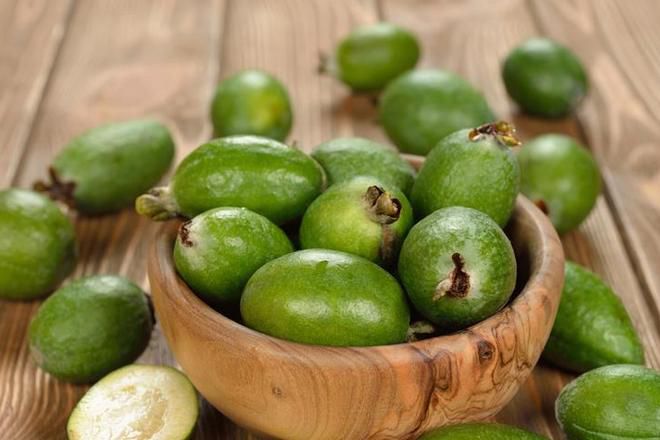

Types and varieties of feijoa
Of all the feijoa grown in our latitudes, the most famous varieties of the Crimean and foreign selection. For example:
- Superba - a variety with large, almost round, aromatic fruits;
- Coolidge - cultivar of foreign selection with elongated oval berries;
- Light - one of the most popular varieties with round-oval or elongated-oval fruits in a dark green bumpy skin with a blush, which gradually brightens when the fruit ripens. The pulp of the berries has a pleasant taste, reminiscent of strawberry;
- Nikitskaya - Feijoa, very similar in description to the previous variety. The pulp has a refreshing sweet and sour taste;
- Lumpy - variety with rounded bumpy fruits with few seeds;
- Early aromatic - variety with fruits with smooth skin, delicate aromatic pulp of sweet and sour taste and a lot of seeds;
- Firstborn 120 - a medium late variety with small fruits of various shapes in a light green peel with a yellowish tinge. The fruits contain a large number of seeds.
In addition to those described, the varieties Nikitskaya 42, Nikitskaya 3, Krymskaya early, Yaltinskaya, Andre and Choiseash are popular.
- Areca at home: care and photos
Contraindications and harm
In some cases, these berries should not be consumed:
- with an excess of iodine in the body;
- with diabetes mellitus: before using these fruits, you should consult a doctor;
- with allergies: individual intolerance to feijoa is quite rare, but it should be borne in mind that these fruits are unusual for the inhabitants of our latitudes;
- children under one year old;
- these berries do not combine with milk and can cause stomach upset.
You should also not eat too much of this product. It will be helpful in moderation.
How to peel fruits
The fruit has a hard peel rich in vitamins. However, its taste is not for everybody, since the peel is a little bitter. Therefore, it is recommended to eat only the pulp. Regardless of who thinks: feijoa is a berry or a fruit, it is difficult to peel the fruit, because the inner side of a moderately ripe fruit, unlike the shell, has a soft jelly-like consistency.
For those who do not know, feijoa is what kind of fruit is, and how it is, lovers of exotic delicacies recommend scraping the pulp from the cut halves with spoons.
If the feijoa fruit is used for cooking, then the peel is left - this is a storehouse of vitamins. For example, when cooking jam, the berry is cut into thin slices. If compote is being prepared, the fruit can be cut into halves. For salads, the feijoa fruit can either be peeled or scooped out with a spoon - it all depends on the recipe. You just need to rinse the berries well, sorting ripe fruits with a wormhole.
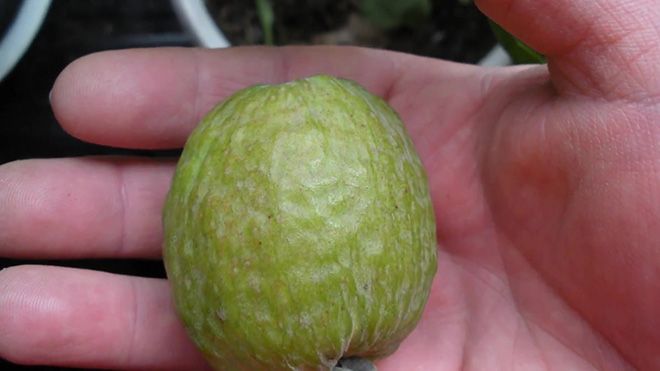

Beneficial features
Feijoa fruits are useful for the prevention and treatment of thyroid diseases, atherosclerosis, vascular congestion, vitamin deficiency. With diseases of the gastrointestinal tract, gastritis with low acidity, diseases of the kidneys and urinary tract, pyelonephritis. For treatment, fresh fruits mashed to a state of puree are used, or decoctions and infusions. Feijoa peel is astringent and therefore of little use for food. But the decoction from the peel precisely because of these properties is an excellent anti-inflammatory agent. Feijoa is an excellent antioxidant.
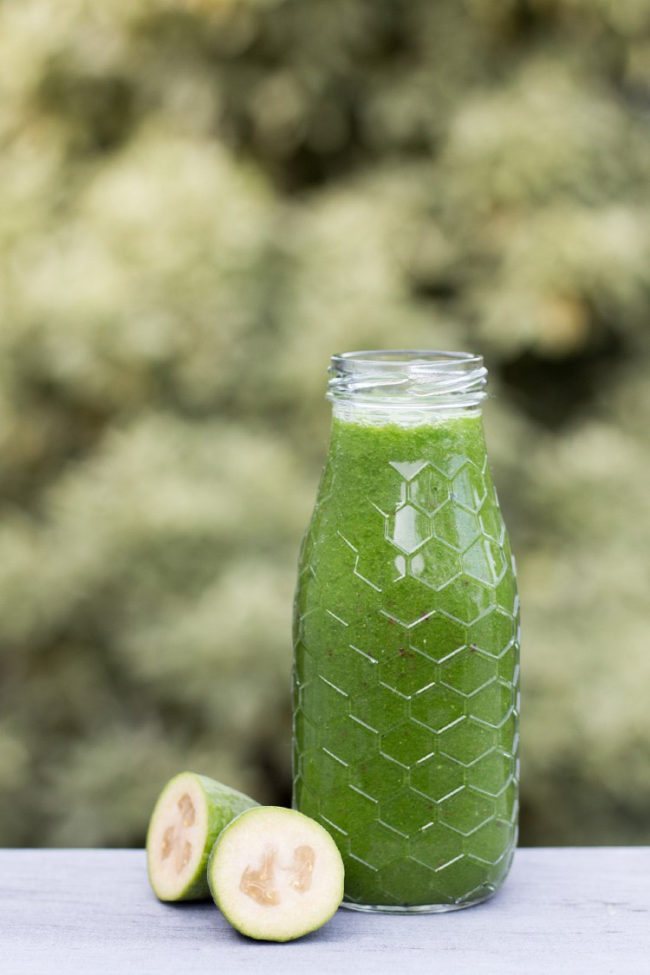

Feijoa juice
Adepts of traditional medicine believe that regular consumption of fruits in food has a preventive effect on cancer. Feijoa is usually eaten fresh, or mashed from mashed fruits with sugar. They also make jam, jam or compote. Processed fruits are used in the confectionery industry to make candies, candied fruits, cake decorations and cocktails.
Feijoa properties - harm and benefit
Useful properties of feijoa
In addition to its pleasant taste and aroma, feijoa fruits have properties beneficial to human health. They contain iodine, zinc, manganese, copper, iron, phosphorus, magnesium, potassium, calcium, sodium, malic and folic acids, essential oils with strawberry and pineapple aroma, vitamins C, PP, B1, B2, B3, B5, B6 as well as easily digestible fats and proteins. There is more iodine in feijoa fruits than in seafood, and berries of trees growing near the sea are especially rich in this element: in 100 g of fruits up to 35 mg of iodine, with a daily intake of 0.15 mg for humans.
The use of feijoa fruits is recommended for vitamin deficiency, atherosclerosis, colds, sluggish intestinal motility, diseases of the digestive system, gout, Graves' disease, constipation and pyelonephritis. Feijoa lowers cholesterol and increases hemoglobin, improves blood composition and memory.


Feijoa fruits are also used externally: masks made from their pulp rejuvenate and nourish the skin of the face, soothe inflamed areas: 1/3 of the crushed fruit is mixed with yolk, two tablespoons of cottage cheese and one tablespoon of olive oil; the mixture is applied to the face and neck, and after 20 minutes washed off.
Feijoa composition
The chemical composition of the feijoa fruit is unusually diverse and rich in useful elements: vitamin C, fiber, pectin, sucrose, micro- and macroelements. The peel of the fruit contains phenolic compounds, kakhetins, biologically active substances. Feijoa is comparable to seafood in the presence of such an important substance as iodine. The pulp contains water-soluble iodine compounds - up to 40 mg per 100 g of product. It should be borne in mind that only fruits grown in the inconsequential proximity to the sea have this amount.
How to use feijoa correctly
Considering the topic: "Feijoa, useful properties and contraindications, reviews", you need to focus on how to eat the fruit correctly.
It is possible to enjoy real gustatory qualities only when there is ripe feijoa. But it is not often possible to buy the fruit when it is fully ripe, because it is harvested not fully ripe. This becomes the cause of rapid spoilage. You can't eat spoiled fruit.
Some people unknowingly eat feijoa like kiwi, cutting off the top skin and cutting the flesh into slices. In fact, they need to be eaten along with the peel, which contains all the nutrients.

